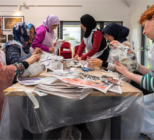Kilmartin Museum’s Prehistoric Collection has become the 50th to be recognised across Scotland for its fundamental importance to understanding the nation’s history. The selected collections span the length and breadth of the country, from Shetland to Dumfries and Galloway, and chart centuries of Scottish history.
Scotland’s Recognition Scheme celebrates, promotes and invests in Nationally Significant Collections beyond those held in the country’s national museums and galleries. The Scheme is administrated by Museums Galleries Scotland on behalf of the Scottish Government.
“We are fortunate in Scotland to have the most inspiring history and heritage right on our doorstep,” Scottish culture secretary, Fiona Hyslop, noted. “The Recognition Scheme serves to highlight Scotland’s most important national and international collections containing some of our best quality artefacts and artworks.
“I would like to congratulate Kilmartin Museum on becoming the 50th collection. It will be in prestigious company, among collections from all parts of Scotland which help us to understand a wide range of stories, spanning thousands of years of Scotland’s history.”
Many of objects within Kilmartin Museum’s Prehistoric Collection were discovered or excavated at the Neolithic and Bronze Age sites and monuments in Argyll’s Kilmartin Glen, near the museum’s present location.
Dr Katie Stevenson, chair of the Recognition Committee, described the Collection as a “remarkable asset to understanding the importance of this period and of the area to the earliest centuries of settlement in what is now Scotland”.
Kilmartin Museum’s curator and director, Dr Sharon Webb, added: “The artefacts are well worthy of this status, and it is a great achievement for the whole organisation that we have been successful.
“Kilmartin Museum is soon to be transformed into a state-of-the-art visitor attraction and centre for archaeological engagement and learning. We are deeply honoured that our new galleries will open in 2022 with a Nationally Significant collection as their centrepiece.”










